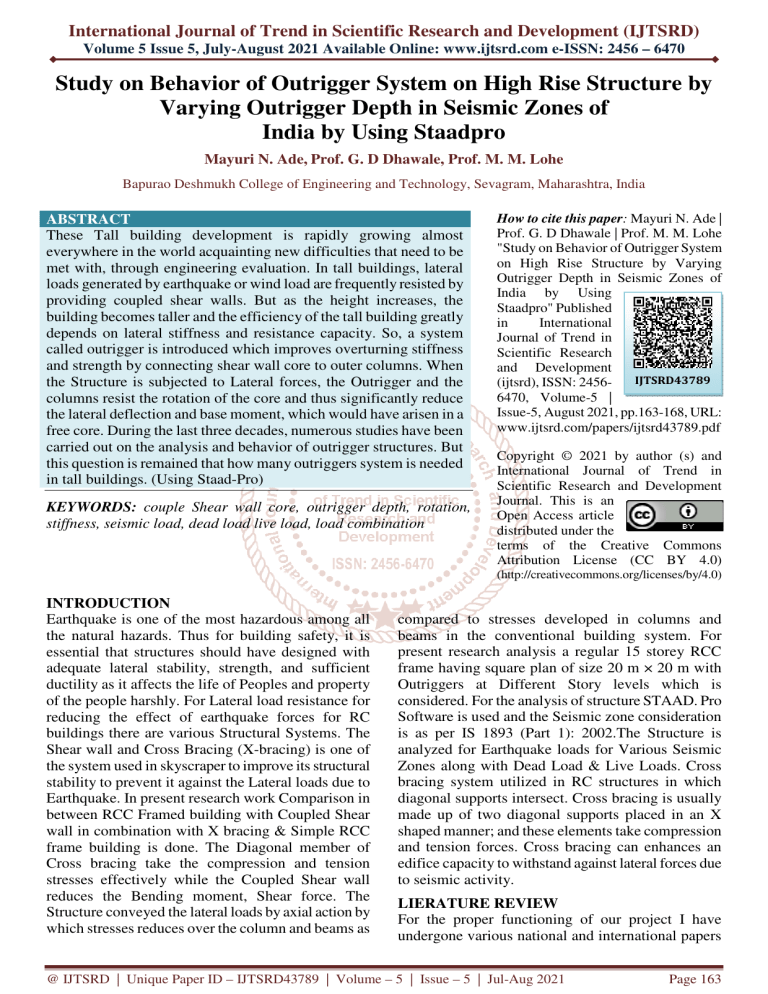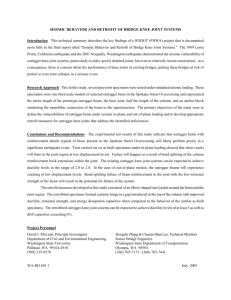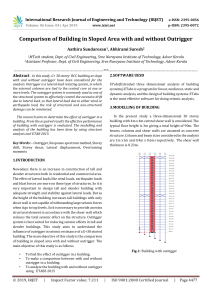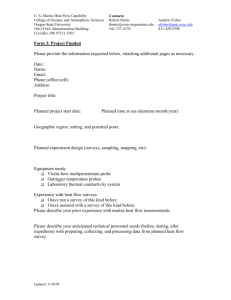
International Journal of Trend in Scientific Research and Development (IJTSRD)
Volume 5 Issue 5, July-August 2021 Available Online: www.ijtsrd.com e-ISSN: 2456 – 6470
Study on Behavior of Outrigger System on High Rise Structure by
Varying Outrigger Depth in Seismic Zones of
India by Using Staadpro
Mayuri N. Ade, Prof. G. D Dhawale, Prof. M. M. Lohe
Bapurao Deshmukh College of Engineering and Technology, Sevagram, Maharashtra, India
ABSTRACT
These Tall building development is rapidly growing almost
everywhere in the world acquainting new difficulties that need to be
met with, through engineering evaluation. In tall buildings, lateral
loads generated by earthquake or wind load are frequently resisted by
providing coupled shear walls. But as the height increases, the
building becomes taller and the efficiency of the tall building greatly
depends on lateral stiffness and resistance capacity. So, a system
called outrigger is introduced which improves overturning stiffness
and strength by connecting shear wall core to outer columns. When
the Structure is subjected to Lateral forces, the Outrigger and the
columns resist the rotation of the core and thus significantly reduce
the lateral deflection and base moment, which would have arisen in a
free core. During the last three decades, numerous studies have been
carried out on the analysis and behavior of outrigger structures. But
this question is remained that how many outriggers system is needed
in tall buildings. (Using Staad-Pro)
KEYWORDS: couple Shear wall core, outrigger depth, rotation,
stiffness, seismic load, dead load live load, load combination
How to cite this paper: Mayuri N. Ade |
Prof. G. D Dhawale | Prof. M. M. Lohe
"Study on Behavior of Outrigger System
on High Rise Structure by Varying
Outrigger Depth in Seismic Zones of
India by Using
Staadpro" Published
in
International
Journal of Trend in
Scientific Research
and Development
IJTSRD43789
(ijtsrd), ISSN: 24566470, Volume-5 |
Issue-5, August 2021, pp.163-168, URL:
www.ijtsrd.com/papers/ijtsrd43789.pdf
Copyright © 2021 by author (s) and
International Journal of Trend in
Scientific Research and Development
Journal. This is an
Open Access article
distributed under the
terms of the Creative Commons
Attribution License (CC BY 4.0)
(http://creativecommons.org/licenses/by/4.0)
INTRODUCTION
Earthquake is one of the most hazardous among all
the natural hazards. Thus for building safety, it is
essential that structures should have designed with
adequate lateral stability, strength, and sufficient
ductility as it affects the life of Peoples and property
of the people harshly. For Lateral load resistance for
reducing the effect of earthquake forces for RC
buildings there are various Structural Systems. The
Shear wall and Cross Bracing (X-bracing) is one of
the system used in skyscraper to improve its structural
stability to prevent it against the Lateral loads due to
Earthquake. In present research work Comparison in
between RCC Framed building with Coupled Shear
wall in combination with X bracing & Simple RCC
frame building is done. The Diagonal member of
Cross bracing take the compression and tension
stresses effectively while the Coupled Shear wall
reduces the Bending moment, Shear force. The
Structure conveyed the lateral loads by axial action by
which stresses reduces over the column and beams as
compared to stresses developed in columns and
beams in the conventional building system. For
present research analysis a regular 15 storey RCC
frame having square plan of size 20 m × 20 m with
Outriggers at Different Story levels which is
considered. For the analysis of structure STAAD. Pro
Software is used and the Seismic zone consideration
is as per IS 1893 (Part 1): 2002.The Structure is
analyzed for Earthquake loads for Various Seismic
Zones along with Dead Load & Live Loads. Cross
bracing system utilized in RC structures in which
diagonal supports intersect. Cross bracing is usually
made up of two diagonal supports placed in an X
shaped manner; and these elements take compression
and tension forces. Cross bracing can enhances an
edifice capacity to withstand against lateral forces due
to seismic activity.
LIERATURE REVIEW
For the proper functioning of our project I have
undergone various national and international papers
@ IJTSRD | Unique Paper ID – IJTSRD43789 | Volume – 5 | Issue – 5 | Jul-Aug 2021
Page 163
International Journal of Trend in Scientific Research and Development @ www.ijtsrd.com eISSN: 2456-6470
published. The summary of some important papers
gone through are as below.
1. Ashish Raghuwanshi (2020)
To study the behavior of frame to the new concept of
combine coupled shear wall and x bracing system.
2. Dr. Mahdi Hosseini et al (2019)
This research is done on response spectrum method of
dynamic analysis of RC frame with shear walls under
the effect of Seismic attack.
3. Dharanya et.al. (2017)
Published their research worked on the analysis and
comparison of shear wall and bracings system with
seismic loading condition.
AIM AND OBJECTIVE
1. Prepare To study the Behavior of frame with
Outriggers at Different Story Positions.
2. To determine the variation in forces due to
provision of Diagonal member and cross bracing
system on structure under seismic forces in
different seismic zones.
3. Comparison of results concluded from the
analysis in terms of Max story drift, max story
displacement, base shear in seismic case, story
shear, time period and frequency
METHODOLOGY
In the primary step modelling of conventional bare
frame structure and combine couple shear wall and X
braced frame generated in Staad software. All the
structure are formed with same plan area.
After modelling in design load as per IS 875 and
seismic forces as per Indian standard 1893 :(Part-1)2016 is applied over the structure in Staad-Pro.
Relative comparative study is done on the structures
to understand its behavior in helping the reduction of
lateral forces.
All the results obtained from results are plotted in
graph using MS word
Loadings such as Dead Load, Live Load, Seismic
Loads as per IS code provision is considered and the
model is analyzed.
LOADING
The loadings were calculated partially manually and
rest was generated using STAAD. Pro load generator.
The loading cases were categorized as:
1. Seismic load (As per IS: 1893 (Part-1)-2016)
2. Dead load (As per IS: 875 (Part-1)-1987)
3. Live load (As per IS: 875 (Part-2)-1987)
4. Load combinations (As per IS: 875 (Part-5)-1987)
MODEL DATA:Plan Dimension = 20 m x 20 m (Grid)
Number of Storey of Building = 15 Storey
Shear Wall Thickness = 200 mm
Typical Storey Height = 3.00 m
C/C Distance of Column = 4.00 m
Slab Thickness = 150 mm
Concrete Grade = M25, Steel = Fe500.
Trial Beam Dimension‘s = 230 x 450 mm
Trial colunmn Dimension‘s = 450 x 450 mm
Outriggers Positions at 8th Floor, 10th Floor & 12th
Floor are compared
RESULT AND COMPARISION
1. MAXIMUM STORY DISPLACEMENT (in mm)
Following Table & Figures shows Maximum Story Displacement for Different Outrigger Positions.
OUTRIGGER
OUTRIGGER
OUTRIGGER
BUILDING TYPES
ARRANGEMENT
ARRANGEMENT ARRANGEMENT
AT 8TH FLOOR
AT 10TH FLOOR
AT 12TH FLOOR
ZONE-II
14.666
36.031
14.742
ZONE-III
23.465
23.592
23.516
ZONE-IV
35.198
35.286
35.214
ZONE-V
52.797
52.827
35.214
Story Displacement (in mm)
60
40
20
0
ZONE-II
ZONE-III
OUTRIGGER ARRANGEMENT AT 8TH FLOOR
OUTRIGGER ARRANGEMENT AT 12TH FLOOR
ZONE-IV
ZONE-V
OUTRIGGER ARRANGEMENT AT 10TH FLOOR
@ IJTSRD | Unique Paper ID – IJTSRD43789 | Volume – 5 | Issue – 5 | Jul-Aug 2021
Page 164
International Journal of Trend in Scientific Research and Development @ www.ijtsrd.com eISSN: 2456-6470
2. MAXIMUM STORY DRIFT (in mm)
Following Table & Figures shows Maximum Story Drift for Different Outrigger Positions in all Seismic Zones
OUTRIGGER
OUTRIGGER
OUTRIGGER
BUILDING TYPES ARRANGEMENT ARRANGEMENT ARRANGEMENT
AT 8TH FLOOR
AT 10TH FLOOR
AT 12TH FLOOR
ZONE-II
1.315
3.146
1.239
ZONE-III
2.105
2.055
1.982
ZONE-IV
3.157
3.080
2.972
ZONE-V
4.735
4.618
2.972
3. STORY SHEAR (IN KN) AT 16TH STORY
Following Table & Figures shows Story Shear for Different Outrigger Positions in all Seismic Zones.
OUTRIGGER
OUTRIGGER
OUTRIGGER
BUILDING TYPES ARRANGEMENT ARRANGEMENT ARRANGEMENT
AT 8TH FLOOR
AT 10TH FLOOR
AT 12TH FLOOR
ZONE-II
45.450
31.660
28.650
ZONE-III
72.730
50.660
45.840
ZONE-IV
109.090
75.980
68.760
ZONE-V
163.630
113.970
68.760
@ IJTSRD | Unique Paper ID – IJTSRD43789 | Volume – 5 | Issue – 5 | Jul-Aug 2021
Page 165
International Journal of Trend in Scientific Research and Development @ www.ijtsrd.com eISSN: 2456-6470
4. STORY SHEAR (IN KN) AT BASE
Following Table & Figures shows Story Shear for Different Outrigger Positions in all Seismic Zones.
OUTRIGGER
OUTRIGGER
OUTRIGGER
BUILDING TYPES ARRANGEMENT ARRANGEMENT
ARRANGEMENT
AT 8TH FLOOR
AT 10TH FLOOR
AT 12TH FLOOR
ZONE-II
190.430
131.670
126.620
ZONE-III
304.680
210.670
202.590
ZONE-IV
457.020
316.000
303.880
ZONE-V
685.530
474.000
303.880
5. BASE SHEAR (IN KN)
Following Table & Figures shows Story Shear for Different Outrigger Positions in all Seismic Zones.
OUTRIGGER
OUTRIGGER
OUTRIGGER
BUILDING TYPES ARRANGEMENT ARRANGEMENT
ARRANGEMENT
AT 8TH FLOOR
AT 10TH FLOOR
AT 12TH FLOOR
ZONE-II
223.330
228.490
225.880
ZONE-III
357.330
365.580
361.410
ZONE-IV
535.990
548.370
542.110
ZONE-V
803.990
822.550
542.110
6. FREQUENCY (IN CYCLE/SEC) CALCULATED FOR RESPONSE SPECTRUM
Following Table & Figures shows Frequency calculated for Response Spectrum for Different Outrigger
Positions & Mode Shapes.
OUTRIGGER
OUTRIGGER
OUTRIGGER
BUILDING TYPES ARRANGEMENT ARRANGEMENT ARRANGEMENT
AT 8TH FLOOR
AT 10TH FLOOR
AT 12TH FLOOR
MODE SHAPE -1
0.747
0.728
0.726
MODE SHAPE -2
0.747
0.728
0.726
MODE SHAPE -3
1.060
1.028
1.028
MODE SHAPE -4
2.314
2.473
2.445
MODE SHAPE -5
2.314
2.473
2.445
MODE SHAPE -6
3.247
2.473
3.589
@ IJTSRD | Unique Paper ID – IJTSRD43789 | Volume – 5 | Issue – 5 | Jul-Aug 2021
Page 166
International Journal of Trend in Scientific Research and Development @ www.ijtsrd.com eISSN: 2456-6470
7. TIME PERIOD (IN SEC) CALCULATED FOR RESPONSE SPECTRUM
Following Table & Figures shows Time Period calculated for Response Spectrum for Different Outrigger
Positions & Mode Shapes.
OUTRIGGER
OUTRIGGER
OUTRIGGER
BUILDING TYPES ARRANGEMENT ARRANGEMENT ARRANGEMENT
AT 8TH FLOOR
AT 10TH FLOOR
AT 12TH FLOOR
MODE SHAPE -1
1.339
1.375
1.377
MODE SHAPE -2
1.339
1.375
1.377
MODE SHAPE -3
0.944
0.973
0.973
MODE SHAPE -4
0.432
0.404
0.409
MODE SHAPE -5
0.432
0.404
0.409
MODE SHAPE -6
0.308
0.280
0.279
8. SPECTRAL ACCELERATION CALCULATED FOR RESPONSE SPECTRUM
Following Table & Figures shows Spectral Acceleration calculated for Response Spectrum for Different
Outrigger Positions & Mode Shapes
OUTRIGGER
OUTRIGGER
OUTRIGGER
BUILDING TYPES ARRANGEMENT ARRANGEMENT ARRANGEMENT
AT 8TH FLOOR
AT 10TH FLOOR
AT 12TH FLOOR
MODE SHAPE -1
1.016
0.989
0.988
MODE SHAPE -2
1.016
0.989
0.988
MODE SHAPE -3
1.441
1.398
1.397
MODE SHAPE -4
2.500
2.500
2.500
MODE SHAPE -5
2.500
2.500
2.500
MODE SHAPE -6
2.500
2.500
2.500
@ IJTSRD | Unique Paper ID – IJTSRD43789 | Volume – 5 | Issue – 5 | Jul-Aug 2021
Page 167
International Journal of Trend in Scientific Research and Development @ www.ijtsrd.com eISSN: 2456-6470
CONCLUSION
1. It has been observed that for Earthquake Analysis
of Building Storey Displacement and Drift is
reducing with provision of Outrigger at Higher
height.
[4]
Dipendu Bhunia, Vipul Prakash, and Ashok D.
Pandey A Conceptual Design Approach of
Coupled Shear Walls Hindawi Publishing
Corporation ISRN Civil Engineering Volume
2013, Article ID 161502.
2. The Maximum Story Displacement & Drift is
reduced by the use of Outrigger arrangement in
Building.
[5]
Motamarri Sarat Chandra, B. Sowmya
Behaviour of Coupled Shear Walls in MultiStorey Buildings, International Journal of
Engineering Research & Technology (IJERT)
IJERT ISSN: 2278-0181 IJERTV3IS120621
www.ijert.org (This work is licensed under a
Creative
Commons
Attribution
4.0
International License.) Vol. 3 Issue12,
December-2014.
[6]
Pail S. P. , Desai R. M. , Khurd V. G.
Comparison of Shear Wall and Bracing in RCC
Framed Structures International Journal for
Research in Applied Science & Engineering
Technology (IJRASET) Volume 4 Issue XII,
December 2016 ISSN: 2321-9653.
[7]
Dharanya,
Gayathri,
Deepika
(2017)
Comparison Study of Shear Wall and Bracings
under Seismic Loading in Multi- Storey
Residential Building International Journal of
chemtech research oden (USA): IJCRGG,
ISSN: 0974-4290, ISSN(Online) Vol.10 No.8,
pp 417-424, 2017.
[8]
Yogesh Babulkar & Rashmi Sakalle (2017)
Comparative Study of Tall Structure with and
Without X- Bracings and Shear Links of
Different Material, IJSRD - International
Journal for Scientific Research & Development
Vol. 5, Issue 09, 2017
3. For 16 storey Building with provision of
Earthquake load, Storey Displacement reduces
from 52.797 mm with Outrigger at 8th Floor to
35.214 mm for Outrigger at 12th Floor under
Seismic Zone-V, which shows that Displacement
reduction with Higher the Outrigger Position.
4. The Outrigger structural systems not only
efficient in controlling the top displacements but
also play significant role in reducing the Story
Shear at Top.
5. The use of Outrigger structural systems in highrise buildings increases the stiffness and makes
the structural more efficient under lateral load.
6. Outrigger system is quite efficient in reducing
effect of Seismic load.
REFERENCES
[1] G. IS 1893 (Part 1):2016,” Criteria for
Earthquake Resistant Design of Structures”,
Bureau of Indian Standards, New Delhi.
[2]
IS: 875 (Part 1&2)-1987 Code of practice for
Design loads (Other than Earthquake) for
buildings and structures, Bureau of Indian
Standard, New Delhi.
[3]
IS 456:2000, Indian Standard Code of Practice
for Reinforced Cement Concrete, Bureau of
Indian Standards, New Delhi.
@ IJTSRD | Unique Paper ID – IJTSRD43789 | Volume – 5 | Issue – 5 | Jul-Aug 2021
Page 168






